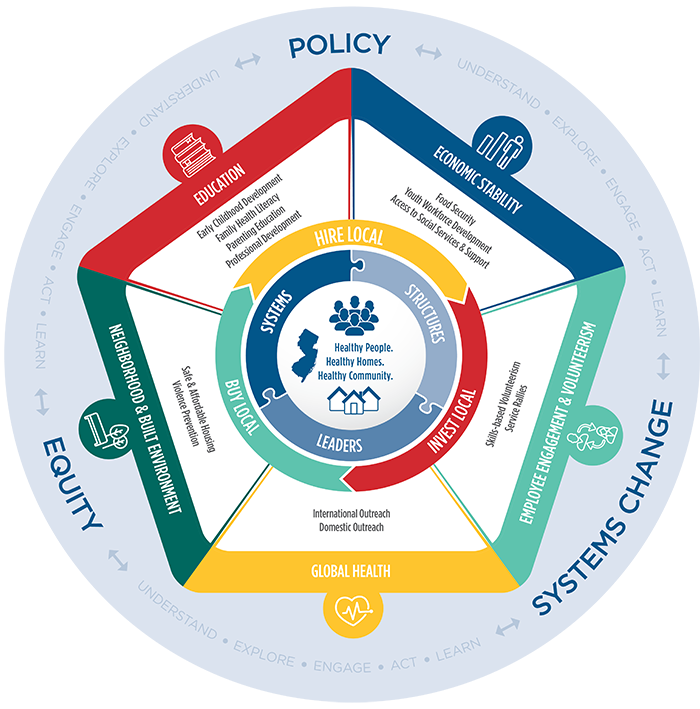Social Impact and Community Investment
Social Impact and Community Investment in Action, RWJBH Corporate Anchor Roundtable Report
The RWJBarnabas Health Social Impact & Community Investment practice (SICI) leverages RWJBarnabas Health’s broad range of assets to advance a culture of health and improve the quality of life for communities throughout New Jersey. The Social Impact & Community Investment practice is rooted in ensuring health equity, by advancing strategic policy change, combined with evidence based and innovative programs that address the social, economic, and environmental conditions that have a significant impact on health outcomes. The Social Impact & Community Investment practice at RWJBarnabas Health also serves as a driver of the system’s anchor mission to Hire Local, Buy Local, and Invest Local.
Once a quarter, the Social Impact & Community Investment practice co-chairs a Corporate Anchor Roundtable (CAR) meeting with RWJBarnabas Health President and Chief Executive Officer Mark Manigan. During the meeting, asset leaders and internal stakeholders lead discussions to highlight the successful implementation of our anchor mission (Hire Local, Buy Local, Invest Local) and review the opportunities and challenges surrounding further adoption of initiatives that address the social determinants of health.
Did You Know?
Socioeconomic, behavioral, and environmental factors affect 80% of all health outcomes. Social determinants such as diet, exercise, stress, sleep habits, housing quality, job status, personal safety and transportation, all play a role in our wellness.
-
39%
New Jerseyans cannot meet their basic needs
-
23%
of households struggle with overcrowding, high housing costs, or lack of kitchen or plumbing facilities
-
10.3 %
New Jerseyans are food insecure
The RWJBarnabas Health Response
RWJBarnabas Health is committed to being in and of the communities we serve. In order to meet our goal to create healthier communities, we reach beyond the doors of our facilities to not only treat disease, but to help avert it. With the goal to improve health outcomes, promote health equity, and eliminate health care disparities, RWJBH has developed a strategy to proactively address the clinical and social factors that affect health outcomes.
Focused on five key pillars, the System meets its social impact goals by effectively serving as an anchor institution in the communities it serves, the System commits to “Hire Local, Buy Local, Invest Local”. This means that we will:
- We will use our purchasing power, and facilitate inclusive, local sourcing, to create and scale opportunities for our local and diverse communities to build wealth
- We will create good jobs and clear career paths inside and outside our organization for members of our local communities
- We will use our financial investments to lift up our local communities and neighborhoods, tackling their key social determinants of health such as education, access to healthy food, affordable housing, and safe living and neighborhood environment.
The five pillars—Economic Stability, Education, Employee Engagement & Volunteerism, Global Health, and Neighborhood and Built Environment, are strategically addressed through the co-design of evidence-based strategies with key local, state, and national partners. Social Impact and Community Investment efforts are rooted in equity, policy, and systems change. RWJBH understands that in order to create strong, healthy, and sustainable communities, we have to re-engineer and transform current systems. We want to ensure that all individuals across the region and the State can achieve better health outcomes. By working to affect policies and streamline practices, we can exponentially scale our impact, helping our communities today and into the future.
Find out more about each of our pillars, our approach to the work, and our successes:






